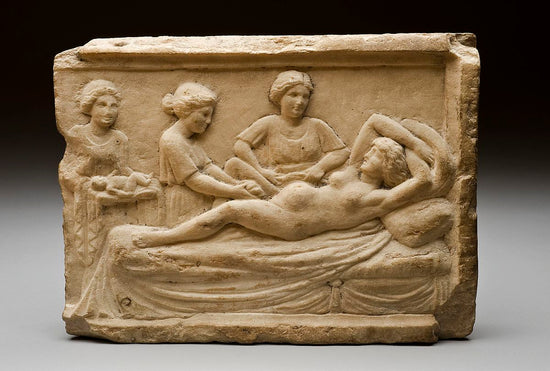Talking About Trichomoniasis
It's Trichy... Tr-tr-tr-trichyyyyy!
Now we've done our Run-DMC impression, it's time for our latest instalment of no-blushes, non-judgemental info on infections: some sexually transmitted, some due to an imbalance in vaginal pH (or the body’s environment), some due to the people being more susceptible to allowing the germs to grow and others which are ‘just one of those things’. Infections are caused by an invasion and growth of germs in the body. These germs can be bacteria, viruses, yeast, fungi, parasites or other microorganisms. Today, we delve into a sexually transmitted infection - trichomoniasis (pronounced ‘trick-om-on-iya-sis’), let’s do this!
What is Trichomoniasis?
Trichomoniasis (commonly referred to as “trich”) is a sexually transmitted infection caused by a protozoan parasite called Trichomonas Vaginalis. A parasite is an organism that lives in or on another species (its host) and survives from this host’s nutrients. Shudder.
How do I get Trichomoniasis?
Trichomoniasis can be spread through vaginal, oral or anal sex, as well as genital touching. You get the infection by having sex with someone who has it, typically, spreading through contact between a penis and a vagina, but you can also get trichomoniasis through purely vaginal contact.
Where does trichomoniasis infect?
The protozoa parasite lives in the vagina and urethra (the tube that runs from the bladder to outside of the body), and the urethra and occasionally the prostate gland. The infection rarely goes further into your body, so can be less serious than some other sexually transmitted infections (STIs).
How do I know I have Trichomoniasis? What are the symptoms of Trichomoniasis?
It can be pretty trichy to know you have it. Roughly 70% of people infected with trichomoniasis don't have any symptoms, but even without symptoms, you are able to pass on the infection. If symptoms do occur, they can include genital itching, a bad-smelling thin vaginal discharge, discharge from the penis, burning with urination, and pain with sex.
Does trichomoniasis smell?
The characteristic smell of trichomoniasis is a pungent fishy odour.
How common is trichomoniasis?
You might not have heard of it, but Trichomoniasis is the most common non-viral sexually transmitted infection in the world. It's also the commonest curable STI in the US, yet is less common here in the UK.
There are only around 6,000 cases of trichomoniasis each year, compared to over 200,000 of chlamydia cases, and in England, over 90% of diagnosed trichomoniasis cases are in women. It is also more common in people under the age of 25 and there are ten times as many cases of trichomoniasis in black ethnic minority populations as there are in the general population. However, it is thought that many cases are still not diagnosed, so the actual number is likely to be higher than recorded.
How do I prevent getting trichomoniasis?
As trichomoniasis is sexually transmitted, by not having sex you are getting rid of this risk - but that's not realistic, or an enjoyable prospect, for many of us. Using condoms will help reduce your risk of getting trichomoniasis, as well as being tested for STIs before having sex with a new partner (which is good practice anyway!). Top tip: avoid douching, as this can affect your vaginal pH and lead to bacterial vaginosis, which may increase your risk of acquiring trichomoniasis.
What are the risks of having Trichomoniasis?
Having trichomoniasis increases the risk of developing pelvic inflammatory disease in women, and you’re more likely to develop bacterial vaginosis. It also increases your risk of getting HIV if you have sex with someone with HIV.
Untreated trichomoniasis in pregnancy increases your risk of having a preterm baby, a baby with a low birth weight and also infection after giving birth.
In rare cases, trichomoniasis can cause an infection of the prostate gland (called prostatitis) in men.
Trichomoniasis can cause reduced fertility.
How does Trichomoniasis get diagnosed?
You can be tested for trichomoniasis at your GP or sexual health/ GUM clinic.
If trichomoniasis is suspected, the health professional may take a swab sample of discharge from your vagina or penis. You can also be shown how to take this swab yourself. The sample is then sent to the lab for review. The trichomoniasis parasite may be seen in the genital fluid with a microscope, or the swab sample might be cultured to test for the parasite's DNA.
Sometimes a urine sample in men shows the infection, and smear tests in women can also show the infection.
Trichomoniasis is often one of many other STI tests that are done at the same time.
How is trichomoniasis treated?
Trichomoniasis can be cured with antibiotics, often metronidazole or tinidazole. You will be prescribed these antibiotics by your sexual healthcare professional, and they will advise you to abstain from sex until the treatment has been completed, at least one week after, and once your partner has been treated too.
It is also important for your current and previous (people you’ve had sex with in the past month or so) sexual partners to be treated. This is especially important because many people are re-infected (up to 1 in 5) within three months of being treated for trichomoniasis.
Sometimes this is because their partner has not been treated too, and other cases are due to the infection being resistant to the treatment antibiotics.
Is trichomoniasis curable?
Yes, unlike some other STIs, trichomoniasis can be cured with treatment.
Will trichomoniasis go away on its own?
Sorry, head-in-the-sand-ers. Trichomoniasis is unlikely to go away on its own without treatment. However, it can be treated with a simple course of antibiotics.
Do I have trichomoniasis, thrush or bacterial vaginosis?
Ah, the eternal question. In vagina-owners, BV, thrush and trichomoniasis are all common causes of vaginitis – inflammation and irritation of the vagina, causing unusual discharge. However, the district differentiators of each are the discharge, the smell, and the other symptoms:
- Discharge type and colour- in vaginal thrush the discharge is thick and white (“cottage-cheese” like), in BV it tends to be thin and milky, grey or white in colour, and in trichomoniasis it is often frothy and yellowy/green in colour.
- Discharge smell- the discharge in vaginal thrush tends to not smell, whereas the discharge is foul-smelling or slightly fishy in BV and a pungent fishy smell for trichomoniasis.
-
Other symptoms- vaginal thrush causes itching, trichomoniasis can cause soreness and pain passing urine or during sex, but BV tends not to cause pain or itching.
Phew, if you’re feeling enlightened/inquisitive/concerned, head to our no-holds-barred HANX Life forum to talk it out.
[products tags="cart:women-health"]




















